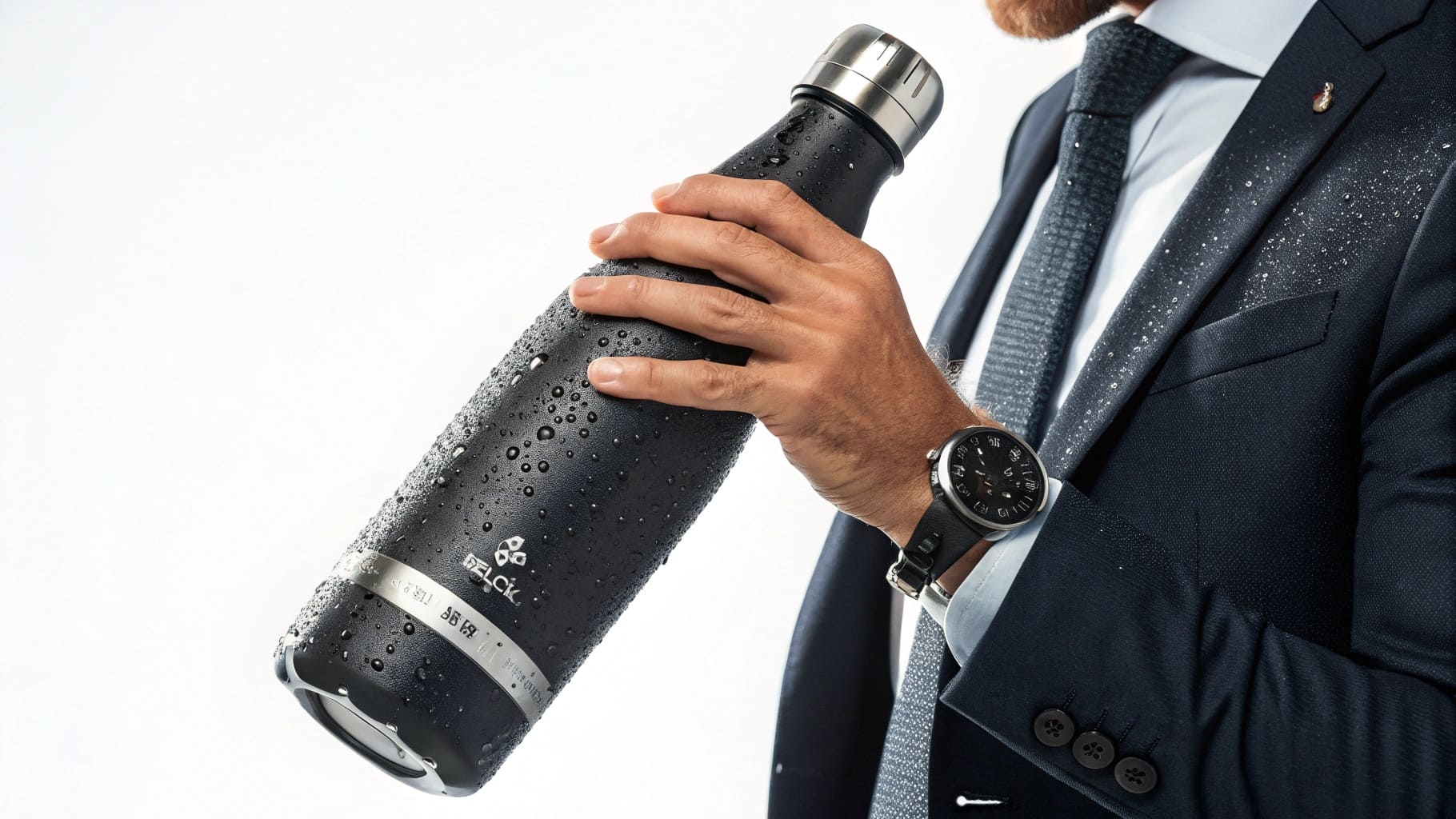Tired of your coffee getting cold or your water warming up too fast? This daily frustration can be solved. The key is choosing the right vacuum insulated bottle.
To find the best vacuum insulated steel bottle, look for a high-quality vacuum seal between the double walls, a copper lining for extra radiation reflection, and a perfectly sealing lid. These features work together to maximize temperature retention.

I've been in the stainless steel products business for many years, working with clients like Mark Shenng from Canada who need top-quality items for their brands. Through my company, Icobottle, I've seen what truly makes a difference in how long a bottle keeps your drink just right. It's not always obvious, so let me share some insights to help you choose. We want you to feel confident when you're looking for your next batch of bottles, knowing exactly what to look for to ensure your drinks stay at the perfect temperature.
How do vacuum insulated bottles keep drinks warm or cold?
Are your drinks losing their ideal temperature too quickly? This can ruin a perfectly good beverage. Understanding the science behind vacuum insulation will help you choose better.
Vacuum insulated bottles work by creating a near-vacuum between two layers of stainless steel. This dramatically reduces heat transfer through conduction and convection, keeping your drinks hot or cold for extended periods.

When we talk about keeping drinks hot or cold, we're really talking about stopping heat from moving. Heat can move in three main ways. Understanding these helps us see why vacuum bottles are so good. I often explain this to my B2B clients, like Mark, who, while a savvy businessman, appreciates a clear explanation of the technology he's investing in for his premium rebranded water bottles in Canada.
1. Conduction: The Touch Barrier
Conduction is heat moving through direct contact. Think of a metal spoon getting hot in a cup of tea. Good vacuum bottles use two walls of stainless steel. The vacuum between these walls is the important part. Because there are very few air molecules in the vacuum, there's almost nothing to conduct heat from the inner wall (holding your drink) to the outer wall (that you touch). This greatly slows down heat transfer1.
2. Convection: The Air Current Stop
Convection is heat moving through the flow of liquids or gases. Imagine steam rising from hot coffee. The vacuum layer in the bottle also stops convection. Since there's hardly any air between the walls, there can't be any air currents to carry heat away from your hot drink or towards your cold one.
3. Radiation: The Invisible Shield
Radiation is heat moving as electromagnetic waves, like the heat you feel from the sun. All objects radiate heat. This is where high-quality bottles add an extra trick. Often, they include a thin layer of copper plated2 on the outside of the inner wall (within the vacuum space). Copper is excellent at reflecting radiant heat. So, if you have a hot drink, the heat trying to radiate out is reflected back in. If you have a cold drink, external heat trying to radiate in is reflected away.
Here's a simple table to break it down:
| Heat Transfer Method | How it Works | How Vacuum Bottles Combat It | Enhanced By |
|---|---|---|---|
| Conduction | Heat transfer through direct physical contact | Double-wall construction with vacuum in between | Quality of stainless steel |
| Convection | Heat transfer through fluid (air/liquid) flow | Vacuum layer minimizes air particles for flow | Integrity of the vacuum seal |
| Radiation | Heat transfer through electromagnetic waves | Reflective materials | Copper lining |
So, a well-made vacuum insulated bottle is a clever piece of engineering designed to fight heat transfer on all these fronts. This is why they are so effective.
Which water bottle maintains temperature best?
Struggling to find a bottle that actually keeps your drink hot all morning or cold all afternoon? It's a common issue. You need one that combines specific design features.
The water bottle that best maintains temperature typically features high-grade 18/8 stainless steel, a superior vacuum seal, a copper-plated inner wall for radiation reflection, and an airtight, well-insulated lid3. These elements are crucial.

When I'm sourcing bottles for Icobottle or advising procurement officers, I always emphasize that not all insulated bottles are created equal. A few key features separate the good from the truly exceptional in terms of temperature maintenance. These are details that someone like Mark, who aims to sell a premium product, would be very interested in.
1. Material Quality: The Foundation
The type of stainless steel used is fundamental. Food-grade 18/8 (also known as 304) stainless steel is the industry standard for a reason.
- Durability: It's resistant to rust, corrosion, and punctures, ensuring the integrity of the vacuum chamber.
- Purity: It doesn't leach chemicals or retain flavors, so your water tastes like water, and your coffee tastes like coffee.
Cheaper bottles might use lower-grade steel, which can compromise both safety and performance over time.
2. The Vacuum: More Than Just Air Removal
Creating a vacuum is one thing; maintaining it is another. The quality of the vacuum seal4 is paramount.
- Seal Integrity: Any leak, however small, allows air back into the space between the walls, enabling conduction and convection. This is often a weak point in poorly manufactured bottles. I've seen cases where a batch of bottles underperforms simply because the vacuum wasn't properly established or sealed during production.
- Degree of Vacuum: A "deeper" vacuum (meaning more air removed) provides better insulation. This is a manufacturing process detail that distinguishes high-quality producers.
3. Lid Design: The Unsung Hero
You can have the best-insulated bottle body in the world, but if the lid isn't up to par, heat will escape or enter.
- Airtight Seal: The lid must create a perfect seal with the bottle's mouth. Silicone gaskets are common, but their quality and design matter.
- Insulation in the Lid: Some lids are also double-walled or contain insulating material. This is especially important for hot beverages, as a lot of heat can be lost through a thin, uninsulated lid.
- Material of the Lid: Lids made from BPA-free plastics are standard, but the thickness and construction contribute to overall insulation.
Consider this breakdown for evaluating bottles:
| Feature | Why It Matters for Temperature Retention | What to Look For |
|---|---|---|
| Stainless Steel Grade | Durability, non-reactivity, maintains vacuum integrity | 18/8 (304) food-grade stainless steel |
| Vacuum Quality | Minimizes conduction and convection | Reputable manufacturer, consistent performance |
| Copper Plating (Internal) | Reflects radiant heat back or away | Mentioned in specs, often a premium feature |
| Lid Seal | Prevents heat loss/gain via air escape/entry & spillage | Tight-fitting, high-quality silicone gaskets |
| Lid Insulation | Reduces heat transfer through the top of the bottle | Double-walled design or internal insulating material |
When you're choosing, especially for B2B purposes where quality reflects on your brand, these details are non-negotiable for superior temperature maintenance.
How to know a good vacuum flask?
Worried about choosing a flask that doesn't live up to its promises? It's a valid concern for buyers. Knowing specific quality indicators can save you from disappointment and protect your investment.
A good vacuum flask is identified by its flawless vacuum integrity, the use of 18/8 stainless steel, an internal copper layer for enhanced insulation, a well-designed, leak-proof lid, and certifications ensuring material safety and quality.

As someone who supplies stainless steel drinkware wholesale, I know that for B2B buyers like Mark Shenng, "good" means reliable, consistent quality that upholds their brand's reputation. It's about more than just the basic claim of "vacuum insulated." Mark's pain points, like inefficient communication or delayed shipments, are often linked to suppliers who might also cut corners on product quality. So, here’s what I advise when looking for a truly good vacuum flask, especially from a B2B perspective.
1. Scrutinize the Vacuum Technology
The core of the flask's performance is its vacuum.
- Manufacturing Process: Ask potential suppliers about their vacuum creation and sealing process. While they might not reveal proprietary details, a confident supplier can discuss their quality control for ensuring vacuum integrity. I remember one factory visit where I saw them testing each bottle individually – that’s a good sign.
- Copper Lining Confirmation: As I mentioned in my insights, that thin copper layer plated on the inner wall (within the vacuum space) is a game-changer for reflecting radiant heat. Not all bottles have it. For premium performance, this is a key feature to ask about and verify. If a supplier highlights this, it shows attention to superior insulation.
2. Material and Construction Details
Little things can indicate overall quality.
- Weld Seams: For stainless steel bottles, look at any visible weld seams (often at the bottom). They should be smooth and clean. Rough or uneven welds can be a sign of lower manufacturing standards.
- Lid Complexity and Material: A good lid is often more complex than it looks. It needs to seal perfectly. Check the quality of the plastic (should be BPA-free), the silicone gaskets (should be robust and fit snugly), and the thread mechanism (should be smooth and secure).
- Certifications: This is crucial for Mark, given his past concerns about occasional certificate fraud. Reputable manufacturers will have and willingly share certifications like FDA, LFGB, or other relevant food-grade safety standards. Always verify these.
3. Performance Indicators and Tests
While you can't always test a sample for 12 hours on the spot, there are clues.
- No Condensation: A properly vacuum-insulated bottle should not "sweat" or have condensation on its outer wall when filled with a cold liquid. This is a quick test. If it sweats, the vacuum is compromised.
- Outer Wall Temperature: When filled with a very hot liquid, the outer wall should remain cool to the touch. If it gets warm, insulation is poor.
Here’s a checklist for B2B buyers focusing on quality:
| Quality Checkpoint | What to Look For/Ask | Why It's Important for a "Good" Flask |
|---|---|---|
| Vacuum Integrity | Inquire about QC for vacuum; no condensation with cold | Core of insulation; prevents heat transfer |
| Copper Lining | Specifically ask if present (inner wall, vacuum space) | Significantly boosts thermal retention (radiation) |
| Steel Grade & Finish | 18/8 (304) stainless steel; smooth, clean welds and finish | Durability, safety, aesthetic, sign of good make |
| Lid Design & Seal | Airtight, robust gaskets, smooth threads, BPA-free | Prevents leaks, maintains temperature at opening |
| Certifications | FDA, LFGB, etc. – request and verify | Ensures material safety and compliance |
| Supplier Transparency | Willingness to discuss manufacturing details, QC | Builds trust, indicates a reliable partner |
My experience with clients like Mark in Canada, who are sensitive to quality but also seek competitive pricing from countries like China, has taught me that focusing on these aspects ensures they get a product that meets their premium standards and avoids common pitfalls.
Conclusion
Finding the best vacuum bottle means checking the vacuum, copper lining, and lid. These key features ensure your drinks stay at the perfect temperature for longer.
-
Learn about the different methods of heat transfer to appreciate how vacuum insulation effectively combats them. ↩
-
Discover the benefits of copper plating in insulation technology and how it enhances heat retention in bottles. ↩
-
Discover the essential features of insulated lids that prevent heat loss, ensuring your beverages maintain their temperature effectively. ↩
-
Learn how a vacuum seal enhances insulation, ensuring your drinks stay hot or cold longer, which is crucial for quality bottles. ↩

